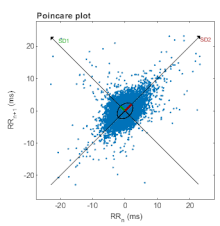Poincare illustration
The Poincaré map (also Poincaré map , first return map , after the French mathematician Henri Poincaré ) is a mathematical method for studying the flow of a continuous n-dimensional dynamic system . To do this, one considers the intersections of a trajectory with an (n-1) -dimensional transverse hypersurface , the Poincaré cut . The Poincaré mapping is the mapping that assigns each of these intersection points to the next and is therefore an (n-1) -dimensional discrete dynamic system.
example
Consider the differential equation and denote with the flow, i.e. the solution to the initial condition . Suppose there is a periodic trajectory, which is a solution that at start and after a certain time returns there . Then one can choose a surface that is transverse to the trajectory and intersects it. All trajectories that start at points near will then intersect the surface again after a certain time. So there is a smallest positive time for which applies. Then the Poincaré map is given by . Specifically, to obtain a trajectory for the periodic checkpoint : . The question of whether the periodic trajectory is stable is now equivalent to the question of whether the corresponding fixed point of the Poincaré mapping is stable.
application
The Poincaré mapping is particularly suitable for the investigation of the geometric structures of chaotic attractors , since the temporal discretization represents a significant simplification.
In cardiology , the display is used when evaluating a long-term ECG . By applying it to the intervals between the respective heartbeats, conclusions can be drawn about cardiac arrhythmias such as atrial fibrillation .
Another application can be found in stress research: here, the parasympathetic and sympathetic influences on the heart rate can be read from the Poincaré images with the two orthogonally aligned diameters SD1 and SD2 ( heart rate variability ).
literature
- Herbert Amann: Ordinary differential equations . 2nd Edition. de Gruyter, Berlin 1995, ISBN 3-11-014582-0 .
- DV Anosov : Poincaré return map . In: Michiel Hazewinkel (Ed.): Encyclopaedia of Mathematics . Springer-Verlag , Berlin 2002, ISBN 978-1-55608-010-4 (English, online ).
- Gerald Teschl : Ordinary Differential Equations and Dynamical Systems (= Graduate Studies in Mathematics . Volume 140 ). American Mathematical Society, Providence 2012, ISBN 978-0-8218-8328-0 ( mat.univie.ac.at ).
Individual evidence
- ↑ Manfred von Ardenne et al .: Effects of physics and their applications . Verlag Harry Deutsch, Frankfurt 2005. ISBN 3-8171-1682-9 , p. 1130



















